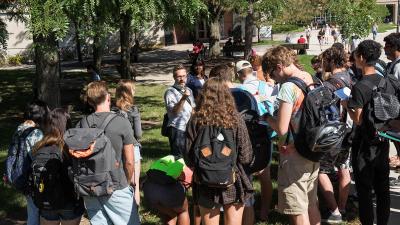Since 1970, there has been a net loss of 2.9 billion birds in the North America - that equates to 1 in 4 birds gone (Rosenberg et al. 2019). This is bad news because birds provide a source of wonder and enjoyment for people around the globe while also providing important services for a stable ecosystem. These declines are being captured by community driven efforts, like the Christmas Bird Count, and by eBird.org. eBird is a huge community driven source of bird sighting data with over 100 million submissions yearly and 142 resulting scientific publications in 2021 alone. Data entered on eBird.org can be used by the public to answer questions about global bird decline, as well as questions about bird biology.

The eBird Community Science Project (CSP) is an 8-week CURE-type lab experience spanning the semester in nonmajor biology courses. Students leverage eBird data to develop and explore novel questions about bird biology through the scientific method. The goal of the CSP is to help students learn about the process of science by actually doing science in an authentic way. We hope that this will improve student scientific literacy to help prepare them to understand and authenticate the science they interact with in their daily lives. Additionally, students learn skills that they can apply to their own disciplines, like data visualization and communicating complex ideas to different audiences. Between Autumn 2020 and Spring 2022 over 1,900 students participated in the eBird Community Science project in both online and face-to-face lab formats.
Over the course of this experience, students will learn how their own observations are used in a database for research and conservation purposes, how to find and use scientific literature and gauge reliability of information, and how to generate testable hypotheses. Each lab will then test its own unique hypothesis about bird biology.
Some hypotheses studied thus far include:
- Bird populations have increased during the covid-19 pandemic due to fewer human disturbances.
- Smaller birds are more often found in groups than larger birds because it provides them protection.
- Birds are more likely to be found in greater numbers and greater species diversity near bodies of water than away from them (excluding all waterbird species) because more food is available.
- Tree cover loss is associated with lower abundance of birds because birds rely on tree cover as important habitat.
- A greater number of birds will be found in rural areas rather than urban areas because of greater human disturbance in urban areas.
- Spring bird migration happens earlier each year due to rising temperatures attributed to global climate change.
As a class, students develop a method to test their hypothesis and learn how to use spreadsheet software to collect and analyze data. By the end of the semester, students will develop a communication artifact that presents the new knowledge they’ve gained to a non-scientific audience of their choice. In the various lab exercises and through the final project, students will be developing and using transferrable skills that will be applicable to their chosen major and future career goals.
We are interested in the effectiveness of the eBird CSP experience to help students achieve the course learning outcomes and develop scientific process skills particularly in relation to our stand-alone lab experiences. To investigate those inquiries, we have been surveying both students and instructors associated with the CSP to assess their perceptions of the CSP and stand-alone labs to meet course learning outcomes and develop science skills. Results are forthcoming.
References:
Rosenberg, K. V., Dokter, A. M., Blancher, P. J., Sauer, J. R., Smith, A. C., Smith, P. A., ... & Marra, P. P. (2019). Decline of the North American avifauna. Science, 366(6461), 120-124
